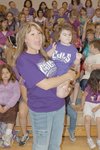

Today isn’t Addison Brown’s birthday, but it’s a significant day just the same for the Crawfordsville toddler and her family.
Addison, 3, is afflicted with Cornelia de Lange Syndrome, a congenital condition caused by a mutated gene. Today marks National CdLS Awareness Day. Since 1989, the second Saturday in May has been designated as such in order to focus attention on this obscure genetic condition.
Common characteristics of those with CdLS include low birth weight, slow growth and small stature and head size. Individuals with CdLS typically have thin eyebrows that usually meet in the middle, long eyelashes, short, upturned noses and thin, down-turned lips. They also may have excessive body hair, small hands and feet, partial joining of the second and third toes, in-curved fifth fingers or cleft palates. They may suffer from gastroesophageal reflux, seizures, feeding difficulties, eye problems, hearing loss, behavioral issues or developmental delays. Some a missing limbs or portions of limbs (typically fingers, hands or forearms).
Most people with CdLS have some degree of mental retardation, which usually ranges from mild to profound. The majority fall in the mild to moderate range.
Addison, a smiling toddler with bouncy brown curls and obvious curiosity, has many of these physical features. She also has a hearing impairment and wears braces to help straighten her legs.
Brown, a former teacher and reading interventionist at Crawfordsville’s Nicholson Elementary, and her husband Sean were already the parents of two sons when Addison joined their family on Aug. 30, 2007. Until Addison made her appearance, her parents had no idea their daughter had any sort of medical problem.
“We didn’t know at all,” Brown said. “She was born here (in Crawfordsville), and the doctors noticed she had a cleft palate and an anomaly of the hand. She was taken to Riley (Children’s Hospital, Indianapolis) right away.”
Doctors at Riley diagnosed Addison quickly.
“They had seen many cases (of CdLS),” Brown said. “They had the information, and they knew. Looks are a very prevalent part of the diagnosis.”
Given her background in education and her dealings with special needs children, Brown “knew what to do” when she found out her daughter had CdLS — it was the emotional part of dealing with the diagnosis for which she was unprepared.
“It was the loss of that idea,” Brown said, her eyes welling with tears. “We already had two sons, and this was our daughter ... I wanted her to be a cheerleader and go to prom.”
Brown wiped her eyes and smiled.
“But that could still happen,” she said. “I have a faith in God. We were picked to have her and to take care of her while she’s here.”
Brown’s mother Deb Hatke works at Nicholson as a special education teacher. She takes special care to integrate her students with the school’s general student population, and to be open to questions.
“We talk a lot about how to treat handicapped people,” Hatke said. “We talk about how in many ways, they’re just like everyone else and we should treat them that way.”
Hatke reacted much like her daughter did to Addison’s diagnosis — as a special education teacher she knew what it meant, but having it hit so close to home was jarring.
“You have a preconceived notion of how this baby is going to be, and your bubble gets a little burst,” she said. “But then you just have to tell yourself ‘It’s this way and it’s not going to change.’”
Last year, Brown resigned from her teaching post at Nicholson in order to be more available for Addison. She goes to Riley for feeding therapy every other week and is slated to start occupational therapy at Riley soon. She also will some type of doctor — whether it be a gastroenterologist, orthopedic, craniofacial or developmental practitioner — at least once a month. Brown now works part-time as a developmental therapist for the First Steps program.
Addison attends developmental preschool classes three times a week at the Willson School in Crawfordsville. There, she receives physical, occupational and speech therapy.
“I have seen major changes in her since she started preschool,” Brown said with a smile. “It has definitely improved her socially. She has started to walk. She claps, and we’re working on waving good-bye.”
Addison’s brothers, 16-year-old Austin and 12-year-old Andrew, are their sister’s “biggest fans.”
“They adore her and she adores them,” Brown said.
CdLS individuals typically have normal lifespans, Brown said, and there is no reason to believe Addison won’t live well into adulthood.
“She was diagnosed right away, and she had all kinds of doctors that keep an eye on her,” Brown said. “It’s when it goes undiagnosed that problems pop up.”
Brown’s former co-workers and the students at Nicholson have spent much time discussing Addison and learning about CdLS. On Friday, many students at the school wore purple, the signature color for CdLS awareness. Addison visited Nicholson that day, accompanied by her mother, and met many of the students.
“We really started doing this because we wanted to support Angie,” said Ellen Rooze, a third-grade teacher at Nicholson.
Sheryl Starnes, another third-grade teacher, agreed.
“We wanted to feel like we were doing something for (Brown) and for Addison,” she said.
On June 11 the Browns will host a yard sale at their home at 29 N. C.R. 400E, Crawfordsville. Several staff and faculty members at Nicholson have purchased CdLS awareness T-shirts, and the funds from both the yard sale and shirt sales will be donated to the national CdLS Foundation.
For more information on CdLS or the CdLS Foundation, visit www.CDLSusa.org.